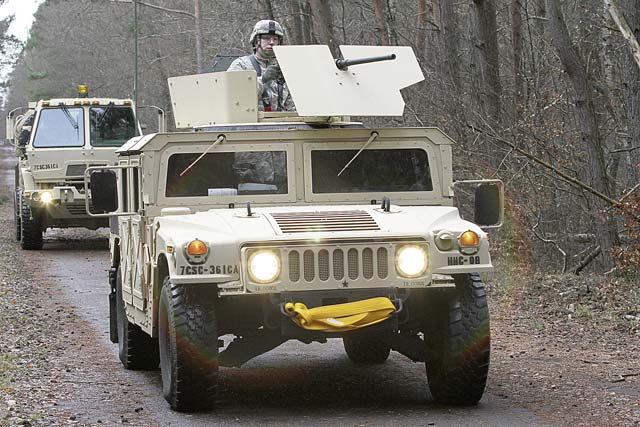
A convoy of 361st Civil Affairs Brigade, 7th Civil Support Command, vehicles moves through the forest Jan. 11 on Rhine Ordnance Barracks.
Loud booms rang out across the forest on Rhine Ordnance Barracks as Soldiers from the 361st Civil Affairs Brigade, 7th Civil Support Command, encountered a simulated roadside bomb as they trained for convoy operations.
For some, it was the first time they experienced an improvised explosive device detonating outside their Humvee. For others, the Jan. 11 exercise was a reminder of the dangers often faced downrange. For Staff Sgt. Daniel Vidican, who has already deployed to a combat zone, the simulated attack was a great refresher.
“This training was really good and very realistic especially with the simulated IED device that was placed on our route,” said Vidican, a civil affairs specialist with Headquarters and Headquarters Company, recalling an IED strike from his deployment.
While noting the real IED he experienced was a lot louder and a lot scarier, the training helps junior Soldiers get in the mindset of what an IED is about, Vidican said. They learn about what to look for while on convoy.
Spc. Adriana Velazquez, who has yet to deploy to combat, knows the training might one day save her life. Velazquez was amazed at how realistic the training was and hopes this was as close she will ever come to an IED, she said. Still, her team learned a lot.
“The training here was really good, and (it’s) amazing how much we did not pay attention before this exercise,” Velazquez said. “Our No. 1 mistake was communication, but this is why this training is planned for us.”
U.S. Army Garrison Rheinland-Pfalz provided the unit with the training area at ROB, a sprawling post located a few miles northeast of Kaiserslautern that once housed ammunition warehouses and is now mostly desolate forestland.
The brigade’s primary mission is to provide civil affairs capabilities to the 21st Theater Sustainment Command and U.S. Army Europe in the U.S. European Command’s areas of responsibility.
However, these Soldiers could also find themselves deployed into more hostile areas where roadside bombs are an ongoing threat. Therefore, convoy training must include how they would react if their column were to face an explosion. The two-day session, offered by former military members who work for a Baumholder, Germany-based contractor, included both classroom instruction and a field exercise.
A three-man training team set up simulators, launched the attack and then held after action reviews with the Soldiers, said Jim Franks, a counter-IED coordination cell trainer. It’s the first time the IED trainers worked with Reserve Soldiers in Europe.
“This will set them up for a larger training scenario when they do their annual training later,” Frank said.
Roadside bombs have been the enemy’s weapon of choice and will continue to be a part of the modern battlefield, said Franks, who served with Marines downrange.
“We hope that our students take away the importance of this training in case they are ever in the IED scenario,” Franks said.







